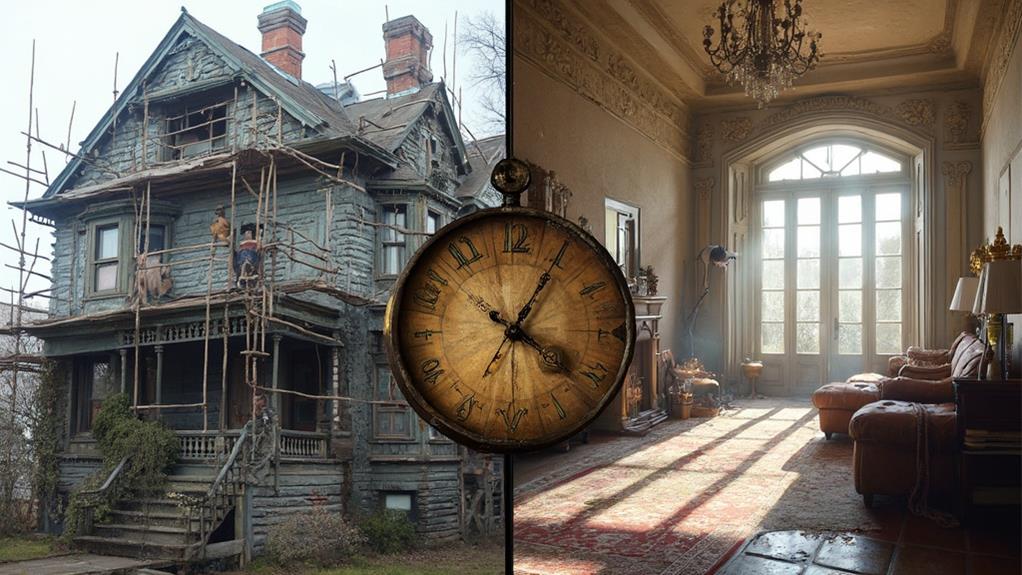Historic home designations significantly impact renovation budgets and timelines. These properties often require specialized materials, skilled craftspeople, and adherence to strict preservation guidelines. Approval processes for modifications can be lengthy, involving multiple stages and public hearings. Sourcing period-appropriate materials is time-consuming and costly, while skilled labor demands higher wages. These factors contribute to extended project durations and increased expenses. However, tax incentives and grants may offset some costs. Insurance considerations and energy efficiency challenges further complicate renovations. Understanding these implications is crucial for homeowners embarking on historic property restoration projects. Exploring the nuances of each aspect reveals the true complexity of preserving architectural heritage.
Understanding Historic Home Designations
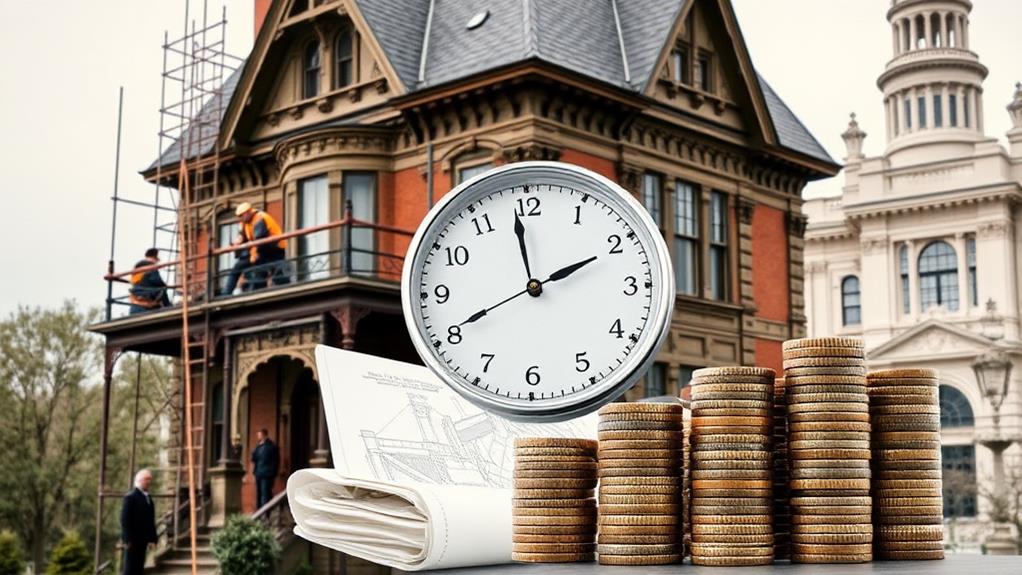
Navigating the world of historic home designations can be complex but crucial for homeowners considering renovations. These designations are typically assigned by local, state, or federal authorities to properties deemed historically significant. The most common types include National Historic Landmarks, properties listed on the National Register of Historic Places, and locally designated historic properties.
Each designation carries different implications for renovation projects. National Historic Landmarks and properties on the National Register often have more flexible guidelines, focusing on preserving the overall character rather than specific details. Local designations, however, can be more stringent, potentially requiring approval for even minor exterior changes.
Understanding your home's specific designation is essential for planning renovations. It determines which regulations apply, what alterations are permissible, and what approval processes are necessary. Homeowners should research their property's status through local historic preservation offices or the National Park Service. This information helps in developing realistic renovation plans, budgets, and timelines, ensuring compliance with preservation standards while achieving desired improvements.
Consulting with preservation specialists or architects experienced in historic renovations can provide valuable guidance in navigating these complexities.
Financial Implications of Preservation
While preserving historic homes can be deeply rewarding, it often comes with significant financial implications for homeowners. The costs associated with maintaining and renovating historic properties typically exceed those of standard homes due to specialized materials, skilled labor, and adherence to preservation guidelines.
Tax incentives can offset some expenses, with federal, state, and local governments offering various programs. The Federal Historic Preservation Tax Credit provides a 20% income tax credit for qualifying rehabilitation projects. However, these incentives often come with strict requirements and may not fully cover the additional costs incurred.
Insurance for historic homes is generally more expensive due to higher replacement costs and potential risks associated with older structures. Homeowners may need to secure specialized policies to adequately protect their investment.
Financing can also be challenging, as some lenders are hesitant to provide mortgages for historic properties. Those that do may require higher down payments or charge higher interest rates to mitigate perceived risks.
Despite these financial hurdles, many homeowners find the long-term value and cultural significance of preserving historic homes outweigh the additional costs, viewing their efforts as an investment in both personal property and community heritage.
Navigating Approval Processes
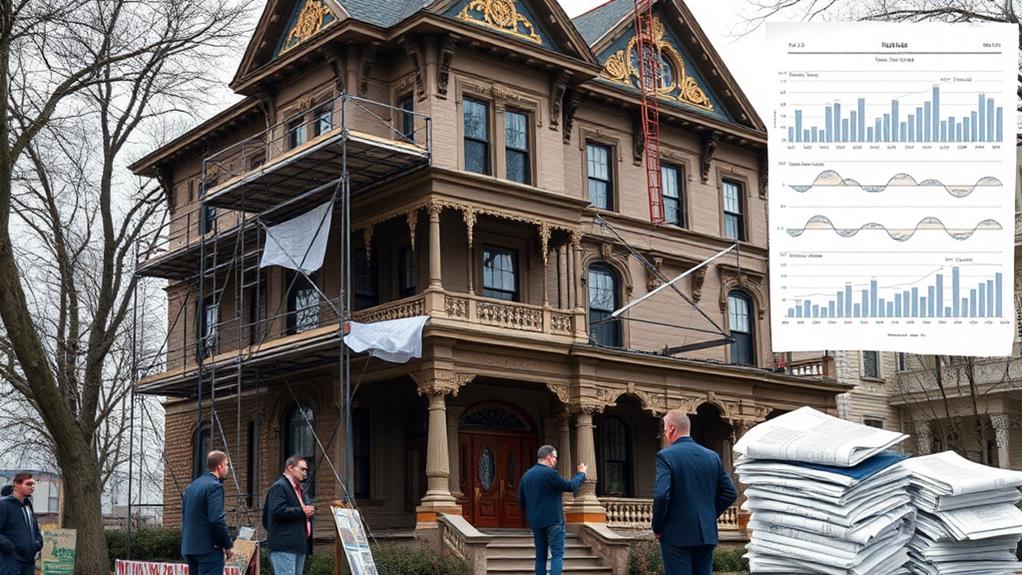
For owners of historic homes, the approval process for renovations can be complex and time-consuming. Historic preservation boards or commissions typically oversee these processes, requiring detailed plans and documentation before granting approval. Homeowners must often submit architectural drawings, material specifications, and historical research to support their proposed changes.
The approval process may involve multiple stages, including preliminary reviews, public hearings, and final determinations. Timelines can vary significantly, ranging from several weeks to several months, depending on the scope of the project and the efficiency of local preservation authorities. Homeowners should factor this extended approval period into their overall renovation timeline and budget.
To navigate the process successfully, it's crucial to engage with preservation officials early and maintain open communication throughout. Hiring an architect or consultant experienced in historic renovations can be invaluable, as they can anticipate potential issues and help craft proposals that align with preservation guidelines. Additionally, researching local preservation ordinances and guidelines beforehand can help homeowners develop renovation plans that are more likely to gain approval, potentially reducing delays and associated costs.
Material Restrictions and Sourcing
One of the most challenging aspects of historic home renovations is adhering to material restrictions and sourcing appropriate materials. Historic preservation guidelines often require the use of specific materials that match the original construction or era of the home. This can significantly impact both budgets and timelines for renovation projects.
Commonly restricted materials include windows, siding, roofing, and interior finishes. Modern alternatives are often prohibited, necessitating the use of traditional materials like wood, slate, or plaster. These materials are typically more expensive and may require specialized craftsmen for installation. Sourcing period-appropriate materials can be time-consuming and costly, as they may need to be custom-made or salvaged from other historic properties.
The scarcity of certain materials can lead to extended wait times and increased costs. For example, finding matching historic bricks or reproducing intricate moldings may require extensive research and collaboration with specialty suppliers. Additionally, some materials may need to be treated or modified to meet current building codes while maintaining their historic appearance, further complicating the sourcing process and potentially extending project timelines.
Specialized Labor Requirements
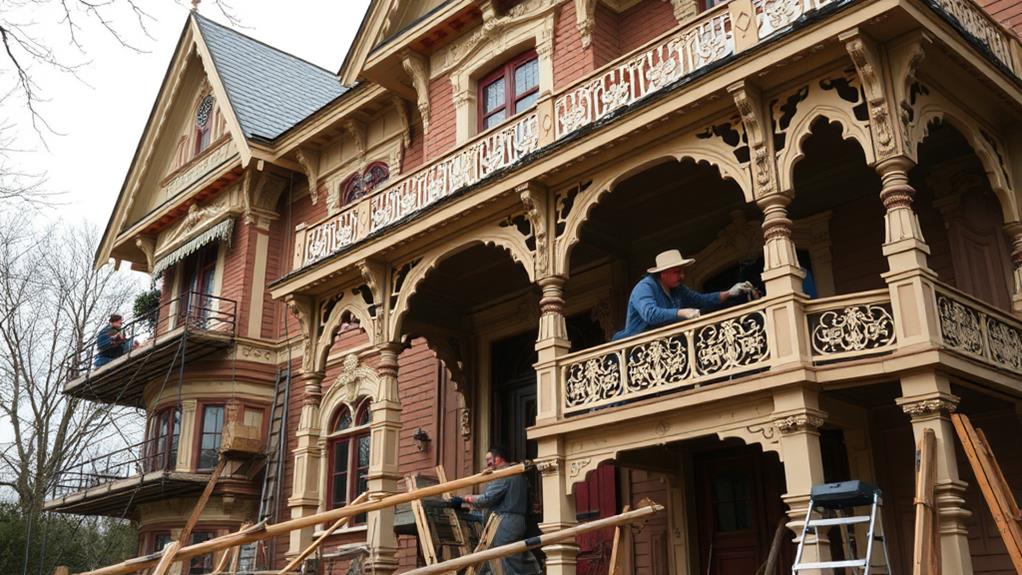
Why are specialized labor requirements so crucial in historic home renovations? The preservation of a historic home's integrity and value hinges on the expertise of craftspeople who understand period-specific techniques and materials. These specialists possess the knowledge to replicate or restore intricate architectural details, from hand-carved woodwork to ornate plasterwork, ensuring authenticity in every aspect of the renovation.
Skilled artisans versed in traditional building methods are essential for tasks such as repairing original windows, restoring masonry, or recreating custom millwork. Their expertise often extends to working with outdated or obsolete materials, adapting modern solutions to maintain historical accuracy. Additionally, these professionals are well-versed in local preservation guidelines and building codes specific to historic structures.
The demand for such specialized labor significantly impacts both budget and timeline. Craftspeople with these niche skills are often in short supply, commanding higher wages and potentially causing scheduling delays. Moreover, the meticulous nature of their work requires more time than standard renovation processes, further extending project durations. Homeowners must factor these considerations into their planning, recognizing that the investment in specialized labor is crucial for maintaining the home's historical significance and long-term value.
Timeline Extensions for Projects
Numerous factors contribute to the extended timelines typically associated with historic home renovation projects. The approval process for modifications to historically designated properties often involves multiple review stages by preservation boards or commissions, which can add weeks or months to the project schedule. Additionally, sourcing period-appropriate materials and fixtures may require extended lead times, as these items are often not readily available and may need to be custom-made or sourced from specialty suppliers.
Unexpected discoveries during the renovation process, such as hidden structural issues or hazardous materials like lead paint or asbestos, can further delay progress. These findings may necessitate additional inspections, remediation efforts, or alterations to the original renovation plans.
The specialized nature of historic restoration work also means that skilled craftsmen may have limited availability, potentially causing scheduling conflicts and delays. Weather conditions can significantly impact outdoor work on older structures, particularly when dealing with delicate materials or intricate details. Lastly, the meticulous nature of historic preservation work itself demands a slower, more deliberate approach to ensure the integrity of the property is maintained throughout the renovation process.
Energy Efficiency Challenges
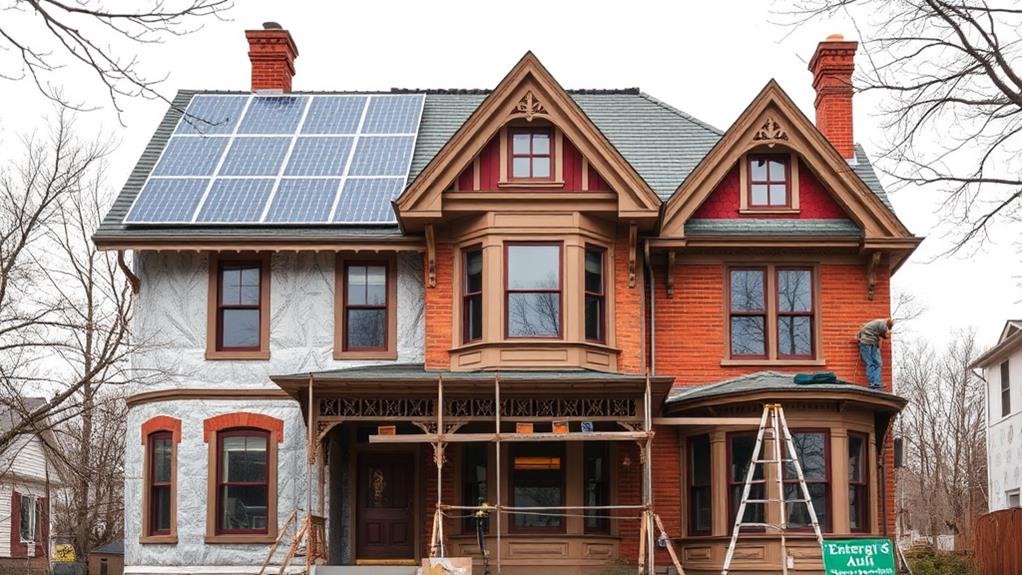
Improving energy efficiency in historic homes presents a unique set of challenges for renovators and homeowners alike. These properties often lack modern insulation, have single-pane windows, and utilize outdated heating and cooling systems. Balancing the need for energy conservation with preserving historical integrity requires careful planning and specialized expertise.
One significant hurdle is updating the building envelope without compromising architectural features. Adding insulation to walls, attics, and crawl spaces must be done in a way that doesn't alter the home's appearance or damage original materials. Similarly, replacing windows with energy-efficient alternatives while maintaining historical accuracy can be costly and time-consuming.
Upgrading HVAC systems in historic homes poses another challenge. Modern, efficient systems may not fit within existing ductwork or architectural constraints. Homeowners may need to consider alternative solutions like ductless mini-split systems or radiant floor heating.
Navigating local preservation guidelines and building codes further complicates energy efficiency improvements. Many alterations require approval from historical commissions, which can prolong the renovation process and limit available options. Additionally, some energy-saving technologies may be deemed incompatible with preservation standards, forcing homeowners to seek creative solutions or compromise on efficiency goals.
Insurance Considerations for Historic Homes
While energy efficiency presents unique challenges for historic home renovations, another important aspect to consider is insurance. Historic homes often require specialized coverage due to their unique architectural features, materials, and historical significance. Standard homeowners insurance policies may not adequately protect these properties, necessitating the purchase of additional coverage or a specialized historic home insurance policy.
Insurance considerations for historic homes include replacement cost coverage, which accounts for the expense of replicating period-specific materials and craftsmanship. Many insurers offer ordinance or law coverage to address the costs of bringing a historic home up to current building codes during repairs. Liability coverage is crucial, as historic homes may attract more visitors or have potential hazards associated with older construction.
Homeowners should also consider coverage for antique furnishings, artwork, and other valuable items often found in historic homes. Some policies offer additional living expense coverage to accommodate extended renovation timelines. It's essential to work with an insurance agent experienced in historic properties to ensure comprehensive coverage that addresses the unique risks and value of these special homes.
Tax Incentives and Grants
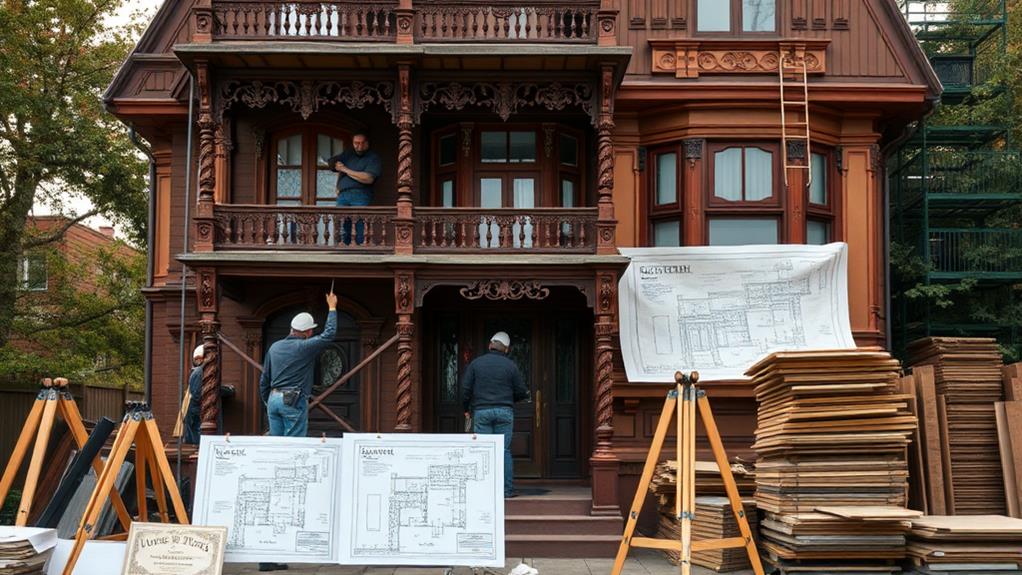
To offset the often substantial costs associated with historic home renovations, various tax incentives and grants are available to homeowners. These financial aids can significantly impact renovation budgets and timelines, making preservation projects more feasible.
Federal tax credits, such as the Historic Rehabilitation Tax Credit, offer a 20% credit for certified rehabilitation expenses on income-producing properties. Some states provide additional tax credits, ranging from 10% to 30%, for both residential and commercial historic properties. These credits can be combined with federal incentives, substantially reducing overall project costs.
Grants from preservation organizations, state agencies, and local governments can provide crucial funding for specific restoration tasks. Examples include facade improvement grants, emergency repair funds, and matching grants for preservation planning. While highly competitive, these grants can cover significant portions of renovation expenses.
Preservation easements offer another avenue for financial relief. By donating a facade easement to a qualified organization, homeowners may qualify for charitable contribution deductions on their federal income taxes. This can provide substantial tax savings while ensuring long-term preservation of the property's historic character.
Resale Value of Designated Properties
The resale value of designated historic properties often becomes a key consideration for homeowners contemplating renovations or potential buyers exploring the market. These properties typically command higher prices due to their unique character, architectural significance, and limited availability. However, the impact on resale value can vary depending on factors such as location, property condition, and local real estate trends.
Designated historic homes in well-preserved districts or sought-after neighborhoods generally appreciate at a faster rate than non-designated properties. The prestige associated with owning a piece of history can attract discerning buyers willing to pay a premium.
Conversely, properties requiring extensive renovations or located in less desirable areas may experience slower appreciation or even decreased value due to the additional costs and restrictions associated with historic designations.
Potential buyers should consider the long-term investment potential, balancing the allure of owning a historic property against the ongoing maintenance costs and limitations on modifications. Sellers should highlight the unique features and historical significance of their properties while providing transparency about any restoration work completed or required.
Ultimately, the resale value of designated properties depends on a combination of market conditions, property-specific factors, and buyer preferences.
Frequently Asked Questions
Can I Remove Historic Designations From My Property?
Removing historic designations from a property is typically challenging and not always possible. The process involves petitioning local or state preservation authorities, providing substantial evidence, and navigating complex regulations. Success rates vary depending on jurisdiction and specific circumstances.
Are There Penalties for Unauthorized Renovations on Historically Designated Homes?
Yes, unauthorized renovations on historically designated homes can result in significant penalties. These may include fines, mandatory restoration to original condition, legal action, and potential loss of the property's historic status. Always consult local preservation authorities before making changes.
How Do Historic Designations Affect Mortgage Rates and Lending Options?
Historic designations can impact mortgage rates and lending options. Some lenders may offer specialized loans for historic properties, while others might view them as higher risk. Interest rates and down payment requirements could be affected, depending on the lender's policies.
Can I Rent Out My Historically Designated Home on Short-Term Rental Platforms?
Renting out a historically designated home on short-term rental platforms may be possible, but it's crucial to check local regulations and any specific restrictions tied to the property's historic status. Consult with local authorities for guidance.
Are There Special Considerations for Historic Homes in Disaster-Prone Areas?
Picture a centuries-old house standing resilient against nature's fury. Historic homes in disaster-prone areas require special considerations, including enhanced structural reinforcement, flood mitigation measures, and tailored insurance policies. Preservation guidelines may also dictate specific restoration methods following disasters.
Conclusion
The labyrinthine journey of renovating a historic home can be as complex as unraveling the mysteries of the universe. While designations present formidable challenges in budgeting, timelines, and regulatory compliance, they also offer unique opportunities for preservation and financial incentives. Balancing modern needs with historical integrity requires meticulous planning and specialized expertise. Ultimately, the value of these properties extends beyond monetary measures, contributing to cultural heritage and community character while potentially yielding long-term financial benefits for homeowners.
